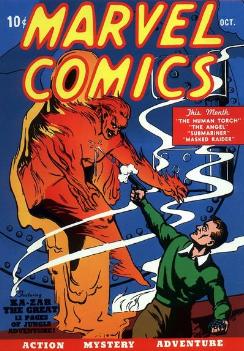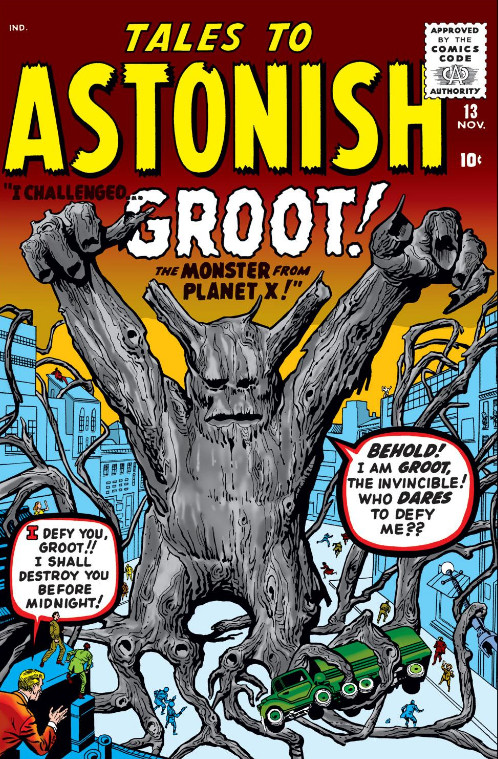Frankly, I've never been one to keep up with current trends and activities, and now as more options are available to us, thanks to technology, I'm even less concerned with keeping up to date culturally. This means that when I discover something new to me, it may already be several years old, even if I'm not exploring something obviously historical, like Charlie Chaplin or Rudy Vallee. Case in point: the animated
Mystery Incorporated series, which started in 2010, and which I obviously had no idea about until just recently.
 |
| No need for a caption - they already included it on the picture: Heavy Meddle! |
Wikipedia tells us that is the eleventh incarnation of
Hanna-Barbera's
Scooby-Doo animated series. Eleven! I grew up watching and enjoying the original episodes, and while as an adult I realize they were really a bit on the simplistic side, they did have a certain atmospheric style and charm to them. I still enjoy watching them for the nostalgia, and for my memories of Saturday morning cartoons while growing up. This first animated series only ran for two seasons, although they were re-run for several years. Subsequent Scooby Doo series just seemed to get sillier with each new show. Even my pre-teen self thought that having "guest-stars" like The Harlem Globetrotters and Batman and Robin was just a cheap gimmick, and took the gang farther away from their atmospheric style. And let's not even get started on Scooby Dum and Scrappy Doo.
 |
| The original show is the best. Or it was till Mystery Incorporated came along. |
So I rather figured that they'd never again do anything to match the original series, much less improve on it. Some time ago, I thought I'd check out The Thirteen Ghosts of Scooby Doo, and it just seemed to confirm my opinion. I mean, half the gang's missing! And there are 'real' ghosts in it, both silly and serious. And a new, young sidekick was introduced--viewer identification or something. Just more kid stuff, and nothing like the original series. Even though the addition of Vincent Van Ghoul (a take-off on Vincent Price) was a nice touch.
But then I saw something about the Mystery Incorporated series, and how it takes the gang back to their roots with a darker edge to it. So I tried it, and wow, this is a good series! It not only incorporates many of the elements of the original series, but also adds some new and interesting touches that are complementary to the series, instead of taking away from it.
First, the gang's all here: Fred, Daphne, Velma, Shaggy, and Scooby Doo. Second, the formula's there: each episode generally consists of some weird creature trying to scare people away from something, the gang investigates, and in the end, they trap the creature and unmask it to reveal that it's just somebody pretending to be the creature, proving that nothing supernatural is actually happening. They even use the "meddling kids" line at the end of each episode.
But they add to the original series in various ways. First, they establish that the gang live in the town of Crystal Cove, "Most Hauntedest Place on Earth". They are clearly teenagers, and are even shown in high school, at least part of the time. We also get to see their parents, and a regular character .in Sheriff Bronson Stone (voiced wonderfully by Patrick Warburton). There's also a certain amount of realism added by the awkwardly romantic relationships between Fred and Daphne, and Velma and Shaggy, with Scooby resenting Velma trying to take Shaggy away from him.
More importantly, there are continuing subplots that carry out over the season(s). There are changes in the romantic relationships over time, and there is a mysterious character Mr. E who helps them on occasion, and who hints at a greater mystery involving the early history of Crystal Cove. As the season goes on, we discover that there was a previous Mystery Incorporated team in Crystal Cove who also solved mysteries, but instead of a dog, they had a parrot mascot by the name of Professor Pericles, who also could talk, like Scooby. In the second season, the mystery grows deeper as we discover that there have been several earlier mystery-solving groups in history, always involving two guys, two girls, and an animal mascot.
Right now, I'm still in the middle of the second season episodes, so I haven't finished watching to see how it all turns out. But this is such an interesting series that I'm really excited about watching each episode.
And there's a certain continuity across episodes, as certain characters appear and reappear, like Hot Dog Water, originally the 'villain' of one episode who returns occasionally, and even replaced Daphne temporarily when Daphne didn't want to be part of the team any more. Vincent Van Ghoul is brought back, initially as the actor in various old horror movies that Scooby and Shaggy like to watch (much like Vincent Price), and eventually is featured in his own episode where he's haunted by the creatures he had played in the movies.
Several episodes borrow from various horror concepts and aspects. One of my favorites involves a Professor Hatecraft, a professor at a nearby college who also writes horror stories. He's a take-off of the horror writer HP Lovecraft. One of his students is one Howard Robertson, a reversal on the name of pulp writer Robert E. Howard.
Still, while the series is more realistic in some respects, it wouldn't be a cartoon if it weren't silly in some ways. Fred's father is the mayor of Crystal Cove, and tries hard to promote the town as the "Most Hauntedest Place on Earth" to encourage tourist trade to the town. Thus, he's usually unhappy when Fred and the gang prove that the latest weird creature was just another fake. Sheriff Bronson Stone is not an especially smart, energetic or dutiful law enforcement officer. He rarely wants to take the trouble to do a full-scale investigation, and he's often just as scared as Shaggy and Scooby when confronted with these strange creatures.
The series makes fun of various aspects of the show. They often play with the line "And I'd have gotten away with it, if it hadn't been for you meddling kids" in various ways. And Fred's not just the guy who comes up with the traps, he's obsessed with traps. He's a subscriber to the magazine Traps Illustrated, often admires various traps and the features that go into traps, and even has names for various types of traps. Fred's also initially oblivious to the feelings that Daphne has for him, although that changes over time.
One especially fun episode has Scooby dreaming of himself teaming up with other Hanna Barbera sidekick characters, Captain Caveman, Jabberjaw, Speed Buggy, and the Funky Phantom. As a nice touch, when Scooby starts dreaming, the animation reverts to a legacy animated style prevalent in the 1970s Hanna Barbera cartoons.
On the other hand, some things remain mysterious about the show. Like the original, the gang proves that the weird creature or creatures of each episode is a fake, yet before they do, we see allegedly normal people in costumes doing truly incredible things, great feats of strength and agility, and even flying in some cases. When they're unmasked at the end, explanations are provided, but they don't seem adequate for the feats they performed. For example, in one episode, some computer geeks dress up as tough but sensitive orc-like creatures and run around on motorcycles. They stop at a roadhouse bar, get into a fight with the local bar patrons, and manage to whoop up on everyone in the bar. Is it believable that wimpy computer geeks could do that, even with a scary costume that makes them seem bigger than they are?
Or in another episode, some college protestors dress up as strange sea creatures, and are able to do amazing things like stay under water for long periods of time without any apparent breathing apparatus or oxygen tanks. They exhibit great strength when attacking a boat and an offshore drilling site, and are able to swim extremely fast and shoot themselves out of the water to great heights. So while they are exposed as being merely humans in costume, their extraordinary feats are never adequately explained.
Furthermore, they never explain how Scooby can be an intelligent dog who talks, and they compound that mystery by introducing Professor Pericles, who is not only an intelligent parrot that can talk, but who also seems to be an evil genius, and not merely of average human intelligence, as Scooby is. Scooby's (and Professor Pericles') unexplained intelligence is the biggest mystery of all, and they don't even try to explain it! At least, not as far as I've watched--I've still got half of Season 2 to go through.
And frankly, while Mystery Incorporated is dedicated to solving mysteries, they show an amazing lack of intelligence at times, and engage in a rather haphazard investigatory style. They also show an amazing lack of interest or curiosity in resolving the underlying mystery of Crystal Cove. Mister E throws a treasure trove of clues and material at them, and they still have to fall back into that mystery in subsequent episodes by accident, instead of deliberately pursuing it. It would be one thing if they stumbled on an episodic mystery while pursuing the Crystal Cove mystery, or if they were to admit they were stumped on occasion, and needed some help or an accidental discovery, but that's not the way they treat it.
Oh well, I guess that just shows that while this is a good animated series, it's *still* just a cartoon. Well worth watching if you can find it on dvd or reruns on a cable channel or somewhere. This series only lasted two seasons, with the last episode aired in April of 2013. Hopefully, they will make more Scooby Doo episodes in this style in the future.






















